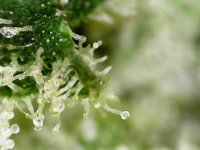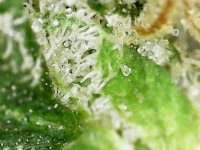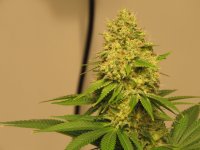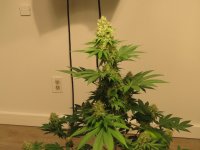The essential facts of timing your harvest
You've managed to make it to the end. You've maintained your plants well, now it's getting closer to harvest time, and you're wondering just how and when to harvest and dry those beautiful buds. Hopefully I can give you some insight into how this can be successfully done; the do's and dont's of proper harvesting and curing. First, lets take a look at the harvest side of things.
Timing of your harvest is critical! Harvesting at maximum ripeness is the key. In my experience, there is usually a five to seven day window when the Cannabis plant will be at maximum ripeness. To understand this, you will need a jeweler’s loupe, or magnifying lens, light optional. I would recommend a power of 30x or better, but you can get by with less. A greater magnification makes it much easier to see the trichome heads at the top of the stalked resin glands.
Resin gland color, potency, and type of high
Gland color will vary with ripeness of the individual THC glands, starting at clear, turning to milky, then turning to an amber color. There may be some exceptions, such as some of the Blue strains and Blackberry. These will have darker, sometimes purple gland heads. But by far and large, these three steps of ripeness will exist with the vast majority of strains on the market. The first stage, clear, will tend to make for a more cerebral, up high, with very little body effect. Harvesting at this stage when little if any trichomes are milky yet, can be tricky. Harvesting too early can make for a beautiful plant that will not have much psychoactive capability! THC needs to "mature" to be able to pass its psychoactive capabilities down to the smoker. This is why I always recommend waiting until 50% of the trichomes hit the second stage: milky or creamy. At this point, you will definitely have a plant which has reached its genetic potential.
The milky trichomes have some "cerebral" qualities, as well as some of the more "physical" characteristics of the high. The last stage, amber, brings on a more sedative, physical stone. If this is what you're looking for, than I would recommend a sativa/indica cross, or an indica dominant plant. Amber trichomes seem to ruin a sativa high if the plant goes too long. The below photo is a good example of a ripe plant: at least 50% of the gland heads have turned "milky," some heads are still clear, and a few are amber. This plant was harvested two days later.
Many times you'll read from new growers, "My hairs are 50% changed to brown or red, looks like its ready to come down." Calyx hairs turning color is one thing, calyx hairs withering, is another. When they have withered, they are for the most part, as ripe as they will get. But just turning red/brown does not necessarily mean the plant is ready. Calyx hairs are just an indicator that the plant is ripening, not necessarily ripe yet. I have taken full Indica strains with 60% hairs turned, and sativas when 90% hairs have turned, and they were all at peak ripeness. The trichome color is the only true indicator!








